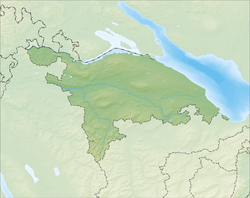Hüttwilen
| Hüttwilen | ||
|---|---|---|
 |
||
|
||
| Coordinates: 47°36′N 8°52′E / 47.600°N 8.867°ECoordinates: 47°36′N 8°52′E / 47.600°N 8.867°E | ||
| Country | Switzerland | |
| Canton | Thurgau | |
| District | Frauenfeld | |
| Area | ||
| • Total | 17.66 km2 (6.82 sq mi) | |
| Elevation | 455 m (1,493 ft) | |
| Population (Dec 2015) | ||
| • Total | 1,669 | |
| • Density | 95/km2 (240/sq mi) | |
| Postal code | 8536 | |
| SFOS number | 4821 | |
| Localities | Hüttwilen, Nussbaumen, Uerschhausen | |
| Surrounded by | Eschenz, Herdern, Mammern, Neunforn, Oberstammheim (ZH), Uesslingen-Buch, Wagenhausen, Warth-Weiningen | |
| Website |
www SFSO statistics |
|
Hüttwilen is a municipality in Frauenfeld District in the canton of Thurgau in Switzerland.
Archeological sites and scattered, individual items indicate that there was a mesolithic settlement in the Seebachtal near Hüttwilen. In 1928 a Roman era estate was discovered in Stutheien which proves that there was a Roman settlement in the area. The modern municipality of Hüttwilen is first mentioned in 1255 as Hutewiler.
In 1466 the village came the rule of the Carthusian monastery at Ittingen. The monastery held the majority of the lower court authority over the village until 1798.
In 1466 the church was built in the village, under the monastery's authority. During the Protestant Reformation in 1529 the village converted to the new faith. The Catholic nobles in the village were able to reinstate the Catholic Mass at the church in 1551. Until 1961 the church was used by both denominations. In 1962 a new Reformed church was built. It was followed in 1964 by a Catholic church. Starting in 1551 the chapel in Uesslingen has been a branch of the Hüttwilen Reformed parish.
For most of the village's history, the main economic activities were wine production, farming and fruit growing. Then, in the late 19th Century livestock and dairy farming were added. In 1900 a hand embroidery plant opened, and into the 20th Century peat was produced. The Seebachkorrektion (Seebach river correction) of 1857-62, and the land improvement projects of 1943-49 opened up new agricultural land. Agriculture was a significant source of income until 1960 when it began to decline in importance and was increasingly replaced by commercial companies. The largest employer is the structure and scaffolding Nussli Group., (2011: 350 employees in Hüttwilen and worldwide). In 1966 the natural and cultural landscape of the Seebach was put under protection which limited development.
...
Wikipedia




